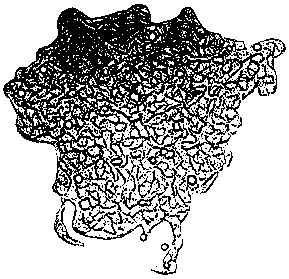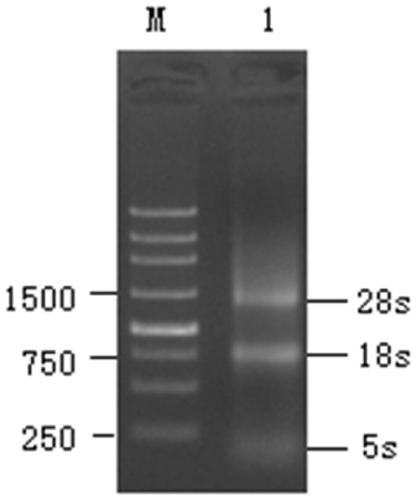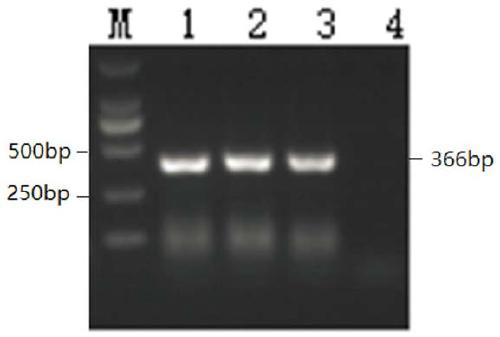Cell BHK/slam/v based on a small ruminant pestilence virus receptor
A technology of Peste des petits ruminants and cells, which is applied in the field of biology, can solve the problems of limited virus strains, low toxicity of virus cells, and impact, and achieve the effect of improving cloning efficiency, good stability, and high purity
- Summary
- Abstract
- Description
- Claims
- Application Information
AI Technical Summary
Problems solved by technology
Method used
Image
Examples
Embodiment 1
[0045] 1. Design, synthesize and clone the vector pDONRTM221P5-P2 and the expression vector pLenti4 / V5-DEST according to the characteristics of the PPRV receptor itself and its coding functional region V gene after translation (SEQ ID NO.1) TM Vector matching primers SEQ ID NO.2 and SEQ ID NO.3, the three sequences are as follows:
[0046] SEQ ID NO. 1: LDLRKGDSPRLEDGYEFHLENLSLRILKSRKED EGWYFISLEENVSVQHFSLQLKLYEQVSTPQIKVLNSTQEDGNCSLMLACVVEKGDHVTYNWSEEAGAPLLSPT NSSHLLYLTLGPQHA;
[0047] SEQ ID NO.2: GGGGACAACTTTGTATACAAAAGTTGTAATG
[0048] CTAGATCTGCGGAAAGGTGACT;
[0049] SEQ ID NO. 3: GGGGACCACTTTGTACAAGAAAGCTGGGTT
[0050] GGCATGCTGAGGGCCAAGAGTGAG.
[0051] 2. Preparation of total RNA related to the receptor of Peste des petits ruminants virus
[0052] Select a healthy goat, collect 50ml of whole blood from the jugular vein, add it to the glass container with anticoagulant before, shake well, add diluent in equal amount, shake well, add goat lymphocyte separation medium...
Embodiment 2
[0068] Steps 1-5 are the same as in Example 1.
[0069] 6. Co-transfect 293-FT cells with the expression backbone and helper plasmids to obtain replication-defective lentivirus-like particles. As above, use the endotoxin-free large-scale plasmid extraction kit to extract a large number of three helper plasmids, pLP1, pLP2 and VSV-G, 750ul opti -Add 12ug of the expression backbone, pLP1, pLP2 and VSV-G to the MEM, add 30ul of p3000 to the other 750ul opti-MEM, and transfect 293-FT cells in sequence according to the instructions of liposome 3000; 8h after transfection The complete medium was replaced, and the 293-FT cell supernatant was aseptically collected for 48 hours. Centrifuge at 5000rpm at 4°C for 5min, discard the cell debris and precipitate, and the collected supernatant is the replication-defective lentivirus-like particles with the receptor of Peste des petits ruminants virus, which are stored in a -70°C refrigerator until the target cells are infected.
[0070] 7. P...
Embodiment 3
[0075] 1-7 steps are with embodiment 1.
[0076] 8. BHK / slam / V cell expression slam / V and its activity analysis
[0077] Select BHK and BHK / slam / V cells in good growth state, digest the normal cells with trypsin, discard the trypsin, collect the cells in the maintenance solution, freeze and thaw repeatedly in the refrigerator, add 500ul RIPA cell lysate (Solabu ), pipet with a gun several times to make the lysate fully contact with the cells, centrifuge at 12000 rpm for 5 minutes after lysis, add 4x sample buffer to the supernatant, boil for 10 minutes, and load the sample on sodium dodecyl sulfate polyacrylamide gel Electrophoresis (12% SDS-PAGE), the protein gel was electroporated using BIO-RAD company ( Turbo) was transferred to a PVDF (polyvinylidene double oxide membrane) transfer membrane, transferred for 7 minutes, washed with PBS 5 times, shaken for 5 minutes each time, and TBST containing 5% skimmed milk powder was added dropwise to block overnight. Wash the membr...
PUM
| Property | Measurement | Unit |
|---|---|---|
| Cell concentration | aaaaa | aaaaa |
| The average diameter | aaaaa | aaaaa |
| Cell concentration | aaaaa | aaaaa |
Abstract
Description
Claims
Application Information
 Login to View More
Login to View More - R&D
- Intellectual Property
- Life Sciences
- Materials
- Tech Scout
- Unparalleled Data Quality
- Higher Quality Content
- 60% Fewer Hallucinations
Browse by: Latest US Patents, China's latest patents, Technical Efficacy Thesaurus, Application Domain, Technology Topic, Popular Technical Reports.
© 2025 PatSnap. All rights reserved.Legal|Privacy policy|Modern Slavery Act Transparency Statement|Sitemap|About US| Contact US: help@patsnap.com



